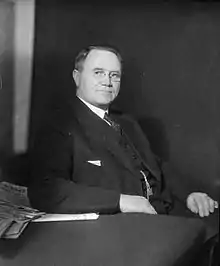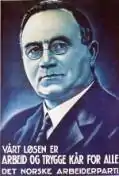Johan Nygaardsvold
Johan Nygaardsvold (Norwegian pronunciation: [ˈnỳːɡoːʂvɔl]; 6 September 1879 – 13 March 1952) was a Norwegian politician from the Labour Party who served as Prime Minister of Norway from 1935 to 1945. From June 1940 until May 1945, he oversaw the Norwegian Government-in-exile from London as head of the Nygaardsvold cabinet during the Occupation of Norway by Nazi Germany.[1] [2]
Johan Nygaardsvold | |
|---|---|
 Nygaardsvold in 1934. | |
| Prime Minister of Norway | |
| In office 20 March 1935 – 25 June 1945 | |
| Monarch | Haakon VII |
| Preceded by | Johan Ludwig Mowinckel |
| Succeeded by | Einar Gerhardsen |
| President of the Storting | |
| In office 11 January 1934 – 20 March 1935 | |
| Prime Minister | Johan Ludwig Mowinckel |
| Vice President | C. J. Hambro |
| Preceded by | C.J. Hambro |
| Succeeded by | C. J. Hambro |
| Parliamentary Leader of the Labour Party | |
| In office 5 March 1932 – 20 March 1935 | |
| Leader | Oscar Torp |
| Preceded by | Alfred Madsen |
| Succeeded by | Sverre Støstad |
| Minister of Labour | |
| In office 20 March 1935 – 2 October 1939 | |
| Prime Minister | Himself |
| Preceded by | Ole Monsen Mjelde |
| Succeeded by | Olav Hindahl |
| Minister of Agriculture | |
| In office 28 January 1928 – 15 February 1928 | |
| Prime Minister | Christopher Hornsrud |
| Preceded by | Ole Bærøe |
| Succeeded by | Hans Jørgensen Aarstad |
| Member of the Norwegian Parliament | |
| In office 1 January 1916 – 31 December 1949 | |
| Constituency | Sør-Trøndelag |
| Personal details | |
| Born | 6 September 1879 Hommelvik, Sør-Trøndelag, United Kingdoms of Sweden and Norway |
| Died | 13 March 1952 (aged 72) Trondheim, Sør-Trøndelag, Norway |
| Political party | Labour |
| Spouse(s) | Albine Regine Brandslet (1878–1961) |
Background
Nygaardsvold was born in Hommelvik, the main centre of the municipality of Malvik in the county of Sør-Trøndelag, Norway. His parents were Anders Nygaardsvold (1839–1897) and Andrea Ratvold (1845–1929). His father was a tenant farmer and a founding member of the first labour union in the area. Johan took his first job as a lumber mill worker when he was 12 years old. On 6 June 1901, he married Albine Regine Brandslet (1878–1961).
Nygaardsvold and his wife emigrated to Canada in 1902 where he took jobs in British Columbia, and in the US in Kalispell, Montana and Spokane, Washington. He and his wife returned to Norway in 1907 after he had followed a career including as an Industrial Workers of the World agitator. In 1909 he found a job at Hommelvik Sawmill.[3]
Political career

In 1910, Nygaardsvold was elected to the board of education for the Labour Party, and rose quickly through the ranks in local politics. In 1916, he was elected to the Norwegian parliament for the first time, serving continuously until 1949. He worked as a labourer in the Swedish lumber industry during the summers in the first few years. From 1920 to 1922 he served as the mayor for his home town of Malvik.[1]
In 1928, Nygaardsvold was appointed minister of agriculture in the short-lived Christopher Hornsrud cabinet. From 11 January 1934 to 20 March 1935 he served as President of the Storting. In 1935, Nygaardsvold was asked to form a government as Prime Minister of Norway. He was serving as Prime Minister when Nazi Germany attacked on Norway 9 April 1940. Following the German occupation of Norway, German officials demanded that the Government headed by Nygaardsvold capitulate and that the King appoint a government headed by Nazi sympathiser Vidkun Quisling. King Haakon VII stated that he could not comply with the German ultimatum and would rather abdicate than appoint Quisling prime minister. On 7 June 1940, the Norwegian Government-in-exile relocated to London. Nygaardsvold continued as prime minister in exile until the government returned to Norway on 31 May 1945. He resigned on 25 June 1945 when King Haakon appointed Einar Gerhardsen to head an interim government composed of all political parties.[4] [5]
A number of progressive reforms were instituted during Nygaardsvold's time as prime minister. The Old Age Insurance Law of July 1936, for instance, introduced national pension insurance, while the Unemployment Insurance Law of June 1938 introduced compulsory unemployment insurance for all employees and workers outside the primary sector “who were compulsorily insured under the sickness insurance scheme; means-tested benefits; those with incomes above or below certain levels not entitled to benefits.”[6]
Johan Nygaardsvold was elected to the Storting for the last time in the autumn of 1945. At the end of the Storting term in 1949, he retired from politics. That same year, he was awarded the Medal for Outstanding Civic Service (Borgerdådsmedaljen). He returned to Hommelvik and died of cancer in Trondheim in 1952. He was buried at Hommelvik Church in Malvik.[7] [8]
Historical legacy
During his time in office, Nygaardsvold had immense popular appeal and was given credit for the Labour Party's election results in 1933. Nygaardsvold was the prime minister in the second Labour Party cabinet in Norway, after he helped formulate the so-called "crisis accord" with the Farmers' Party. His government's domestic policy was largely dedicated to recovering from the Great Depression, but it is most noted for its foreign and military policy in the years leading up to the occupation of Norway by Nazi Germany and his administration in exile from 1940 to 1945. The investigative commission that issued a report after the liberation of Norway found that he could not be absolved from responsibility for the lack of operational readiness for the German invasion, but gave him credit for his management of a unity government in exile. He was awarded an honorary salary for his service in exile, but refused to accept it.[1]
References
- Harald Berntsen. "Johan Nygaardsvold". Norsk biografisk leksikon. Retrieved April 1, 2018.
- "World War II". Det Norske Kongehus. Retrieved April 1, 2018.
- Knut Dørum. "Johan Nygaardsvold". Store norske leksikon. Retrieved April 1, 2018.
- Harald Kjølås. "Johan Nygaardsvold". Allkunne. Retrieved April 1, 2018.
- "Norwegian Government-in-exile". London Remembers. Retrieved April 1, 2018.
- Growth to limits: the Western European welfare states since World War 2: Volume 4 by Peter Flora
- "Johan Nygaardsvold, Statsminister 1935-1945". Regjeringen. Retrieved April 1, 2018.
- "Medaljen for borgerdåd". Det Norske Kongehus. Retrieved April 1, 2018.
Other sources
- Berntsen, Harald (1991) I malstrømmen : Johan Nygaardsvold 1879–1952 (Oslo: Aschehoug) ISBN 9788203228896
Related reading
- Andenaes, Johs; Riste, Olav; Skodvin, Magne (1966) Norway and the Second World War (Oslo: Johan Grundt Tanum Forlag)
| Political offices | ||
|---|---|---|
| Preceded by Johan Ludwig Mowinckel |
Prime Minister of Norway 1935–1945 |
Succeeded by Einar Gerhardsen |
